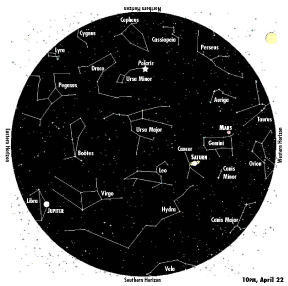 |
Sky Watch
by J. Alex Knoll
|
Hoping for a Shower of Sky Rockets
Lyrids mark first meteors of the year
It's been three months since earth last plowed through the debris trail of one of our solar system’s orbiting comets, leaving a void in meteor activity. We do it again this week with the return of the annual Lyrid meteor shower from April 16 to 25 and peaking in pre-dawn skies Saturday the 22nd.
Each April, earth plows through the debris stream of Comet Thatcher. Made up of cosmic dust and ice typically no bigger than grains of sand, this debris ignites against earth’s atmosphere, creating the pyrotechnics we call shooting stars.
Alas, the display will be marred by the waning gibbous moon, which rises in the southeast around 4am and remains visible until sunset.
The best time to look is between midnight and 4am Saturday, before the waning gibbous moon has risen. Lyrid meteors are as bright as most stars, and you won’t need binoculars or a telescope; the naked eye is better suited to spotting meteors, which streak across the sky, than binoculars or a telescope, which have too narrow a field of vision.
First observed in China around 700bc, the Lyrids typically deliver one or two shooting stars every couple minutes. But sometimes there are far more, as in 1982, when viewers counted upward of 90 per hour. And back in 1803, a Richmond reporter wrote of shooting stars falling “in a manner that alarmed many, and astonished every person that beheld it. From one until three in the morning, those starry meteors seemed to fall from every point in the heavens, in such numbers as to resemble a shower of sky rockets.”
What will the Lyrids do this year? The only way to know for sure is to go outside and look.
